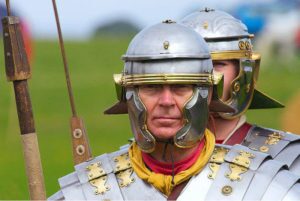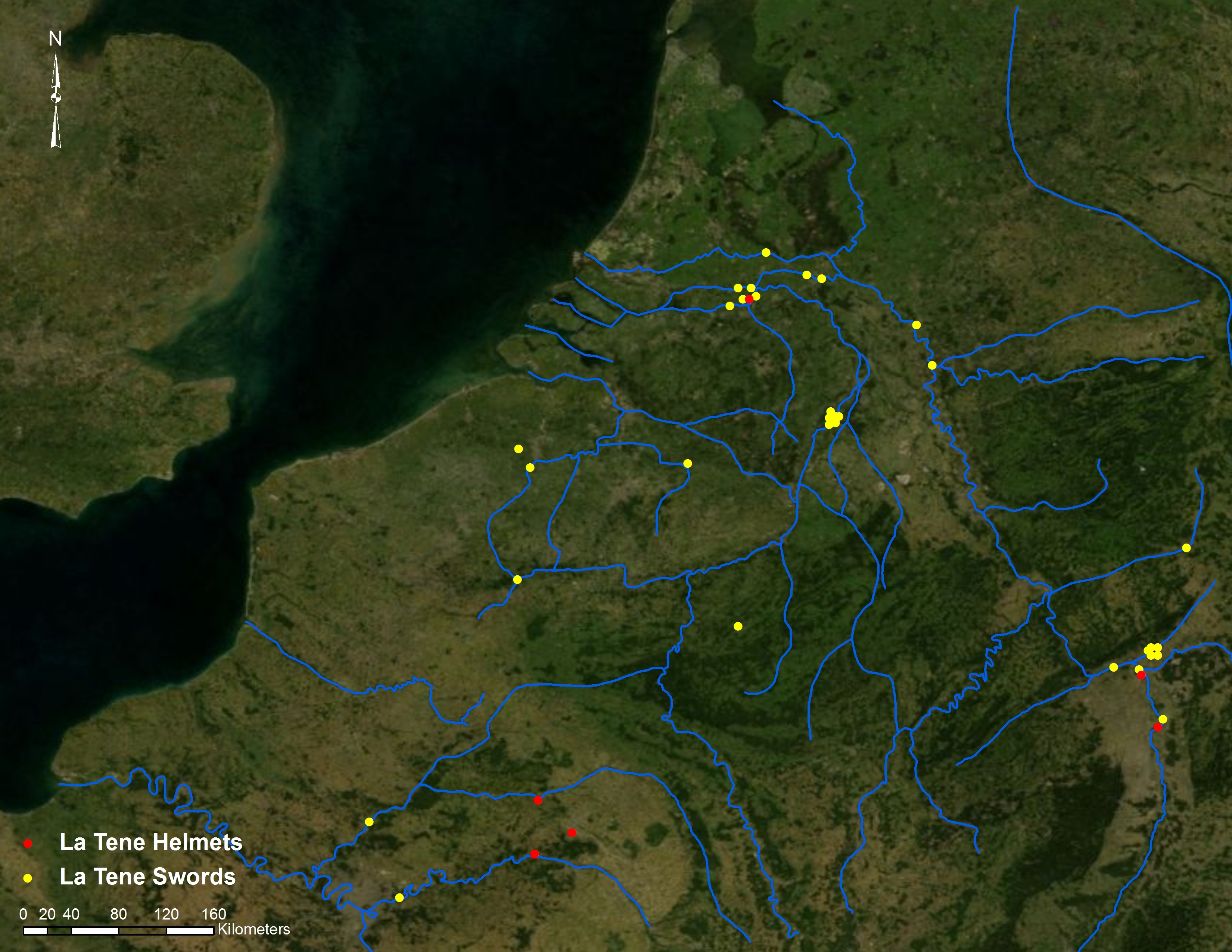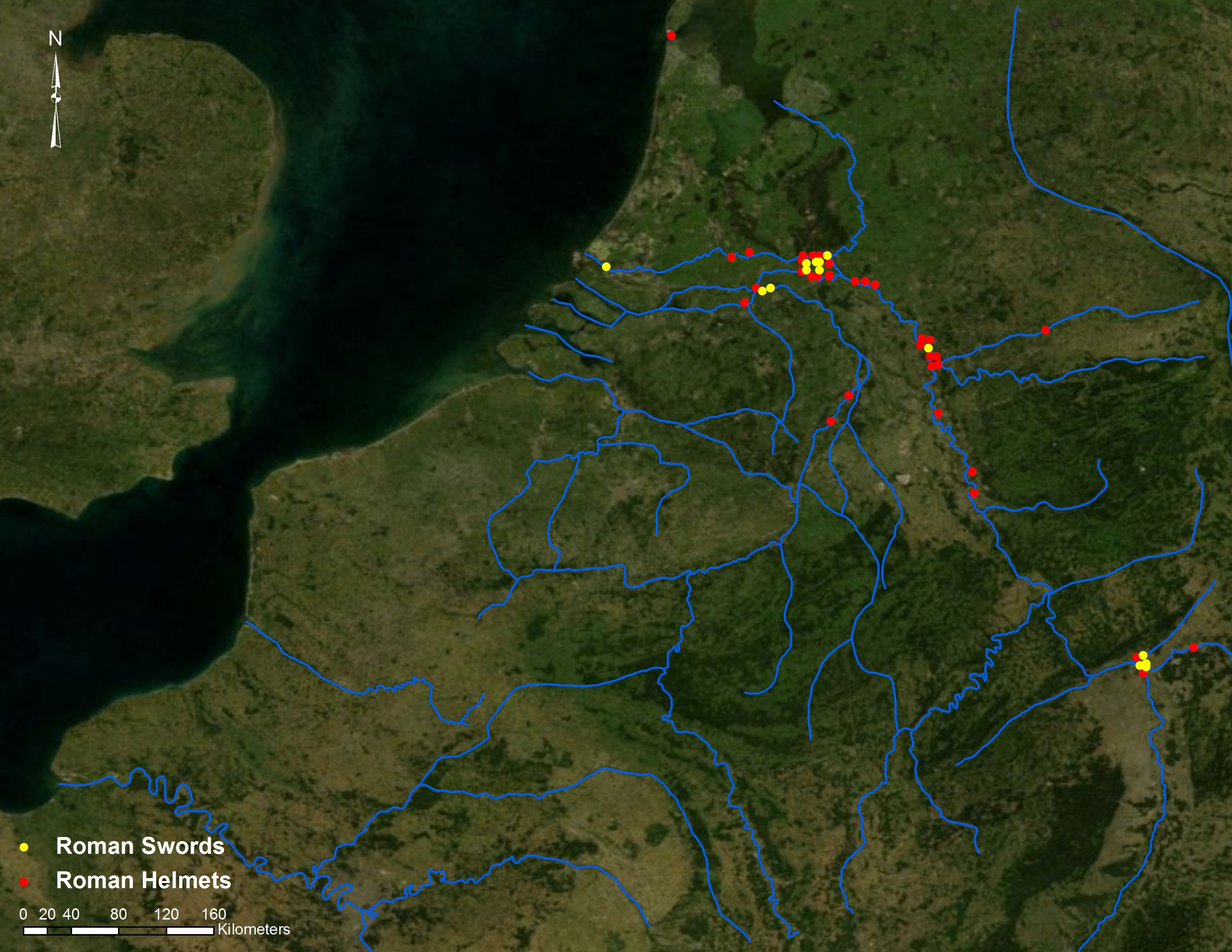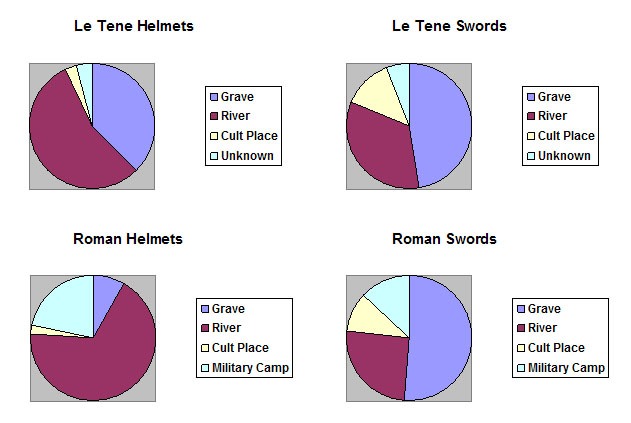
Through chance finds, formal excavations, looting, and dredging operations, several pieces of intact, fully functional Roman weapons and armor have been recovered from aquatic contexts in Gaul and Britain dating from the first century B.C.E to late first century C.E. Some scholars have attempted to explain the phenomenon as a series of accidental losses, while others allude to intentional deposition.[1]Although one cannot completely disregard accidental loss, the facts that military equipment was both expensive and heavily regulated and the veneration of water played an important role in Roman religion suggests that, in the majority of cases, gear found in water was a result of a conscious act, most likely of religious nature.
In Roman religion, the dedication of objects to gods took two forms: votive offerings, items dedicated to propitiate a god, and vows, objects dedicated to fulfill a contract with a deity. The religious rites were integral to the relationship between gods and mortals, as they provided a medium through which humans and the divine could interact. Roman religious practice prescribed a strong tradition of dedicating objects and a veneration of water; yet, few works, both ancient and modern, attest to a tradition of soldiers dedicating gear into water as a religious rite. It is the purpose of this investigation to argue that military equipment recovered from aquatic contexts in the western provinces cannot always be interpreted as accidental loss, but rather through emulation of a widespread Celtic practice, Roman soldiers dedicated weapons and armor into water as a religious rite.
Contextualizing the Assemblage
Examining religious praxis by way of military gear is problematic due to the difficulty encountered when attempting to link artifacts with specific behavior without proper archaeological context. Most equipment recovered from water lacks précis provenience, which is a direct result of recovery. Few formal excavations have been conducted in the major rivers and streams in Gaul and Britain, and several of the examples available for study are byproducts of dredging operations. Although the exact context of artifacts is essential for any study of material culture, understanding the manner in which military equipment became archaeological material helps bridge this gap. The following discussion of the processes of deposition will demonstrate that military arms and armor differed greatly from other material forms because they were never regarded as trash or discarded as such; thus, they entered the archaeological record in more specific and deliberate ways.
Loosely following Schiffer’s life-cycle theory, there are two processes that transform Roman military gear into material culture: cultural deposition processes and depositional processes.[2] Cultural deposition occurred when accoutrements were deliberately discarded or ritually offered in the ground or other concealed places where recovery was difficult. In such cases, the items no longer functioned in their traditional behavioral systems and become incorporated into an archaeological context. These acts include burying gear to prevent others from utilizing it, hoarding, mortuary contexts, cross-cultural utilization and, as will be discussed later, religious dedication. Often, when a garrison stayed at a particular fort for a period of several years, soldiers and officers increased the quantity of their possessions. When it came time to abandon a fort, the army would take what they could and bury the rest, preventing non-Roman forces from utilizing whatever they left behind. During unsettled times, or when abandoning a fort, soldiers would, on occasion, bury valuable possessions in a hoard. For example, the Corbridge hoard in Britain, excavated in 1964, contained an assemblage of equipment that included several pieces of lorica segmentata (metal, plated body armor), spearheads, artillery bolts, nails, wax writing tablets, papyri fragments, iron alloy, copper alloy, and glass fragments.[3] The owner buried the gear inside of an iron-bounded chest covered with a piece of leather. The amount of care taken when interring the items and sheer value of this material demonstrates that the owner planned to reclaim it. In the event of a soldier’s death, a colleague returned his equipment to a repository, buried it with the soldier, or his items simply disappeared. During their service, many soldiers drafted a will indicating who would receive their possessions after death. In some cases gear is found in burial contexts, suggesting it was interred ex testamento (according to a will).[4] Cross-cultural discard occurred when Roman equipment acquired as war booty, tribute, mercenary equipment, and trade objects was deposited in a non-Roman region.[5]
Depositional processes, on the other hand, constituted the accidental loss of fully functional items within a behavioral system. The transformation from the functional context of the gear to the archaeological context is, therefore, accidental. While on campaign, soldiers did, on occasion, lose their equipment. If a unit crossed a river or was suddenly ambushed, it was possible for soldiers to lose weapons and armor in the chaos. Although it is difficult to identify lost equipment archaeologically, Vegetius notes that accidental loss was a concern. He states, “the passages of rivers are very dangerous without great precaution. In crossing wide or rapid streams, the baggage, servants, and sometimes the most foolish soldiers are in danger of being lost.”[6] One must question, however, to what extent the current assemblage represents a traditional depositional process. As stated earlier, gear was expensive and regulated. Strict laws allowed officials to severely punish soldiers for mishandling their equipment. Legal works, such as the ex Ruffo Leges Militates, Corpus Juris Civilis, and the Strategica, preserve laws that forbade soldiers from losing and haphazardly disposing their gear.[7] If a soldier lost his sword, for example, an official could punish him twice, both for disarming himself and for potentially arming the enemy. Punishments for such an offense included, but were not limited to, flogging, a reduction in rank, and death.
Military equipment is unique as, unlike most other artifact types, arms and armor, in whatever condition, were never considered refuse at any point in their life-cycle, and entered the archaeological record in specific ways. Therefore, the processes of deposition are fairly predictable, and the exact context of the material is not entirely necessary for a discussion of the connection between military accoutrements and religion.
Celtic Evidence
The Celtic and Roman traditions of depositing weapons and armor are very similar in practice, and will be compared later to discuss the nature of Roman religion in Gaul and Britain. Celtic religion was deeply rooted in a veneration of water as streams, rivers, lakes, wells, and bogs were sacred places for Celtic worship. Aquatic locations—with the exception of bogs—represented life, curative qualities, fertility, and well-being. Bogs were feared and associated with danger and treachery.[8] Rivers, lakes, and streams became places centered on votive behavior, whereas in bogs individuals made both offerings and sacrifice. It is through the classical sources, presence of Celtic water deities, and the archaeology that Celtic water veneration and the various religious practices associated with it emerge.
In describing the destruction of Tolosa by Quintus Servilius Caepio, both Strabo and Justinus note how the Celtics ritually deposited valuables in sacred lakes.[9] In 105 B.C.E., the Roman proconsul Caepio went to southern Gaul and fought against the Tectosagi. At the siege of Tolosa, he seized a great treasure of gold and silver from a sacred lake, which was identified as the booty seized from Delphi by the Gauls in 279 B.C.E. Caepio committed a sacrilegious act, according to Strabo and Justinus, by draining the lake and taking the treasure. Later that year, Roman forces suffered a disastrous defeat at the Battle of Arausio and, according to Orosius, the Cimbri and Teutoni seized large quantities of booty. Orosius states:
The enemy, after gaining possession of both camps and great booty, by a certain strange and unusual bitterness completely destroyed all that they had captured; clothing was cut to pieces and thrown about, gold and silver were thrown into the river, corselets of men were cut up, trappings of horses were destroyed, the horses themselves were drowned in whirlpools, and men with fetters tied around their necks were hung from trees, so that the victor laid claim to no booty, and the conquered to no mercy.[10]
The gold and silver may have been part of the booty seized by Caepio from Tolosa, given that he was a military leader at the battle. Caepio, after being prosecuted by Norbanus for stealing the Tolosa treasure, was exiled to Smyrna and died.
Classical accounts of Celtic water veneration are not restricted to Caepio. Caesar alludes to a deep respect for water when he describes the subjugation of Uxellodunum in 51 B.C.E.[11] Caesar notes that the inhabitants continued to resist his advance until troops fully blocked a spring running through the settlement. The inhabitants interpreted the dry stream as an inauspicious omen and quickly surrendered. Prudentius, a fifth-century C.E. Roman poet from Spain, describes in his Psychomachia the battle between Pudicitia (Chastity) and Libido (Lust). After Pudicitia defeated and killed Libido with her great sword, Pudicitia cleaned the sword in the Jordan River and deposited the victorious weapon into a religious space. Prudentius writes, “she dedicated it to the altar of the sacred spring in the Catholic temple, eternally shining there it shines with light.”[12] Writing in Gaul during the sixth century, Gregory of Tours offered yet another example of the Celts offering valuable items in water. Gregory writes:
In the territory of Javols there was a mountain named after Hilary that contained a large lake. At a fixed time a crowd of rustics went there and, as if offering libations to the lake, threw [into it] linen cloths and garments that served men as clothing. Some [threw] pelts of wool, many [threw] models of cheese and wax and bread as well as various [other] objects, each according to his own means, that I think would take too long to enumerate. They came with their wagons; they brought food and drink, sacrificed animals, and feasted for three days.[13]
The six classical accounts demonstrate clearly that the Celts and other groups dedicated valuable objects into water and that Roman culture had knowledge of the tradition.
Roman contact with Celtic groups initiated ideological reforms for both cultures. Prior to the Roman conquests of Gaul and Britain, the Celts did not wholly identify the divine physically. According to Green, Roman contact provided a catalyst for Celtic concepts of the divine to be freed from anonymity.[14] It is because of this contact that we can begin to identify specific Celtic water deities and classify them into two categories: those attached to a specific river and those attached to water features. The former category includes Verbia (goddess of the Wharfe River), Sequana (goddess of the Seine River), and Souconna (goddess of the Saone River). The latter includes Sulis (goddess of the springs at Bath among other things), Coventina (goddess of a spring at Carrawburgh), and Condantis (a goddess worshipped in Britain, whose name means “watersmeet”).[15] The deities mentioned above served many functions in Celtic religion, but they also played a role in Roman religious practices in Gaul and Britain.
The Celtic tradition of tossing objects into water as a religious rite originates in the Bronze Age (Hallstatt culture) and lasts through the Roman periods (Le Tene Culture). The archeological evidence for this practice is abundant and extensively studied . Both Wait and Roymans have published comprehensive archaeological accounts of Celtic weapons discovered in water from Britain and Gaul.[16] Wait examines Celtic swords, helmets, and shields in his study of ritual and religion in Britain within three chronological periods: seventh century B.C., Middle Iron Age, and Late Iron Age. Since the focus of the present study is the relationship between Celtic and Roman religious ritual, the material from the Middle Iron and Late Iron ages will be discussed in detail. The Celtic periodization scheme in Britain interprets the La Tene period as beginning at the onset of the Iron Age and ending with the Roman conquest in the first century C.E. Of the 113 Celtic swords dating to the La Tene period discovered in Britain, 66% came from rivers and bogs, 9% came from burials, 1% from hoards, 15% from an archaeological site, and 9% were chance finds. Only three helmets from an aquatic context have been recovered in Britain dating to the La Tene period. Map 1 depicts sword and helmet densities in relation to major rivers in Britain.
__________________________________________________________________________________________

Map 1 (after Wait 1985): Distribution of Le Tene period swords and helmets discovered in aquatic contexts in Britain. Satellite imagery courtesy of Bing.
__________________________________________________________________________________________
Roymans adopted a similar approach in his study of Belgic Gaul. He identified and plotted all the Le Tene swords and helmets from his study area. The periodization scheme for Celtic Gaul differs from the British scheme, as the La Tene period began at the onset of the Iron Age, but ended with the Roman conquest in the first century B.C.E. Of the 15 Celtic helmets found in Belgic Gaul, 27% came from a grave, 40% came from a river, 13% from a cult place, and 20% are of unknown provenience. Of the 109 Celtic swords recovered, 48% are grave finds, 34% came from a river, 13% from a cult place, and 6% are of unknown provenience. Map 2 depicts sword and helmet densities from Roymans’ study area.
__________________________________________________________________________________________

Map 2 (after Roymans 1996): Distribution of Le Tene period swords and helmets discovered in aquatic contexts in Belgic Gaul. Satellite imagery courtesy of Bing.
__________________________________________________________________________________________
Based on classical accounts, the presence of several water deities, and the studies of Wait and Roymans, Celts groups from both the Hallstatt and Le Tene periods had a strong tradition of dedicating military equipment in water for hundreds of years. This tradition both predates and continues well after the Roman conquests of Gaul and Britain. Roman soldiers came into contact with a well-established religious ritual, which, as we will see, was incorporated into their religious system.
Roman Evidence
There is no question that water held a religious significance in Roman culture. In discussing the importance of water in Roman religion during the Republican period, Edlund-Berry argues that, although the use of water figured greatly in religious practices, it was an unofficial, private affair.[17] Although the veneration of water was not an official state-sponsored ritual, it was practiced in the private realm. The sites of several Roman bridges show evidence of religious activity. Archaeologists excavating the intersection of the Via Appia and the Garigliano River at the site of ancient Minturnae uncovered several artifacts, including 4,918 coins deliberately tossed into the river.[18] Moreover, the Thames River within the urban confines of London also produced thousands of coins, demonstrating that offerings of valuable property were made into water.[19] There are, however, no classical accounts that attest to a Roman practice of depositing military gear or other valuables in water as a religious practice, nor are there water deities similar to those found in Celtic Britain and Gaul attested in the Roman pantheon. If, indeed, water veneration was an unofficial, private ritual, as Edlund-Berry argues, and water veneration among non-Roman groups was deemed abnormal as the aforementioned classical sources suggest, it is of little surprise that historical records do not attest to such a ritual within Roman culture. The archaeological record, however, does provide evidence supporting such a religious ritual.
In his study of Romanization in Belgic Gaul, Roymans also examines Roman military equipment. He categorized and investigated the Roman evidence in the same manner as the Celtic material. All Roman gear utilized in his study dates to the first century C.E. Of the 68 Roman swords discovered in Belgic Gaul, 51% are grave finds, 25% are river finds, 10% are from a cultic place, and 13% come from a military camp. Of the 51 Roman helmets from this region, 8% are grave finds, 69% are river finds, 2% are from a cult place, and 22% are from a military camp. Map 3 illustrates sword and helmet densities in relation to the major river systems in northwest Gaul. Unfortunately, Roymans’ study does not incorporate material from Britain. However, military equipment has been recovered from aquatic contexts at Newstead, possibly Corbridge, and the Thames River.
__________________________________________________________________________________________

Map 3 (after Roymans 1996): Distribution of Roman swords and helmets discovered in aquatic contexts in Belgic Gaul. Satellite imagery courtesy of Bing.
________________________________________________________________________________________
It is clear that Roman culture adopted and adapted deities and religious practices from other groups. Mithraism, for example, had a strong following among the Roman army. The Persian god was sent to Earth to kill the sacred bull, whose blood symbolized life forces.[20] Several iconic representations from Britain and Gaul survived, depicting Mithras slaying the primeval bull with a serpent and scorpion trying to prevent the blood from reaching the fertile ground. When Rome expanded into new territories, cultural exchange occurred on both ends; Romanization was never a one-sided affair, and it certainly appears that Celtic culture left an indelible mark on Roman religion in the western provinces.
At least three Roman deities were subjected to substantial Celtic influence while retaining a Roman identity.[21] For example, a goddess identified as Sulis Minerva, worshipped at the Roman site of Bath, attests to a dual cultural origin. The name is preserved in several inscriptions and lead curse tablets.[22] The combining of the Celtic goddess Sulis and the Roman goddess Minerva demonstrate a Romano-Celtic deity. Other hybrid deities include a Celtic Mars and a Romano-Celtic sky god from Britain. A statuette from Martlesham in England depicted a mounted warrior with an inscription dedicating it to Mars Cocidius. An altar from Chester possesses a dedicatory inscription to Jupiter Optimus Maximus Tanarus, who was a Celtic thunder deity from Gaul and Germany.[23]
Discussion and Conclusions
Classical accounts, the presence of specific water deities, and the archaeology of Celtic groups in Britain and Gaul suggest that soldiers stationed in the western Roman provinces witnessed and eventually adopted a strong religious tradition of water veneration, whereby individuals dedicated valuable military gear in water. Comparison of the density maps of the Le Tene and Roman material from Gaul (Map 2 and 3) and the pie charts in Figure 1 (below), provides evidence of a similar practice, though locations of deposition and types of military gear were different. Unlike the Celtic material, Roman helmets far exceed swords, and the highest concentration of Roman gear is found along the Rhine River, the frontier between Rome and Germany. Figure 1 depicts the specific artifact densities of swords and helmets from the Roman and Le Tene periods in Gaul. Despite subtle differences in preferred material types and depositional locales, the archaeology demonstrates a great degree of cultural exchange and continuity in the religious realms of the Celts and Romans.
__________________________________________________________________________________________

Figure 1: Pie charts comparing the depositional practices of Le Tene and Roman period military equipment.
__________________________________________________________________________________________
The hybrid Romano-Celtic deities and the similar practices in the deposition of arms and armor in water paints an interesting picture of Roman and Celtic religion and interaction from the first century B.C.E. to first century C.E. The religious practices of the Roman army did not take over and replace native Celtic forms nor did Celtic religion remain the same. The Roman practice of offering military gear in water was a result of Celtic interaction. The purpose and belief systems behind such a tradition varied across time and space. Celtic culture saw water as a life force, key to wellbeing and fertility. It is impossible to determine if Roman soldiers who dedicated their gear perceived water or their newly adopted ritual in the same way. Although generally, in practice, the Roman and Celtic traditions concerning water appears similar, different cultural and ideological backgrounds gave the ritual a distinctively different meaning.
Cover Photo Top: Roman infantry soldiers. Courtesy David Fiel, Wikimedia Commons
__________________________________________
Works Cited
Alcock, Joan. “Celtic Water Cults in Roman Britain.” American Journal 122 (1965): 1-12.
Allason-Jones, Lindsay, and Mike Bishop. Excavations at Roman Corbridge: the Hoard. London: Historic Buildings & Monuments Commission for England, 1988.
Bishop, Mike, and J. C. N. Coulston. Roman Military Equipment: from the Punic Wars to the Fall of Rome. Oxford: Oxbow Books, 2006.
Brand, C. E. Roman Military Law. Austin: University of Texas Press, 1969.
Breeze, David, Joanna Close-Brooks, J. N. Graham Ritchie, Ian Scott, and A. Young. “Soldiers’ Burials at Camelon, Stirlingshire, 1922 and 1975.” Britannia 7 (1976): 73-95.
Czarnecka, Krystyna. “The Re-Use of Roman Military Equipment in Barbarian Contexts: A Chain-Mail Souvenir?” Journal of Roman Military Equipment Studies 5 (1994): 245-253.
Edlund-Berry, Ingrid. “Hot, Cold, Smelly: The Power of Sacred Water in Roman Religion, 400-100 BCE.” In Religion in Republican Italy, Yale Classical Studies 33, edited by Celia Schultz and Paul Harvey Jr., 162-180. Cambridge: Cambridge University Press, 2006.
Green, Miranda. The Gods of Roman Britain. Oxford: Shire Archaeology, 1983.
Green, Miranda. Celtic Myths. Austin: Texas University Press in cooperation with British Museum Press, 1993.
Klumbach, Hans. Romische Helme aus Niedermanien. Koln: Rheinland-Verlag, 1974.
Oldenstein, Jurgen. “Two Roman Helmets from Eich, Alzey-Worms District.” Journal of Roman Military Equipment Studies 1 (1990): 27-37.
Rald, Ulla. “The Roman Swords from Danish Bog Finds.” Journal of Roman Military Equipment Studies 5 (1994): 227-241.
Rhodes, Michael. “The Roman Coinage from London Bridge and the Development of the City of Southwark.” Britannia 22 (1991): 179-190.
Robinson, H. Russell. The Armour of Imperial Rome. New York: Scribner, 1975.
Roymans, Nico. “The Sword or the Plough. Regional Dynamics in the Romanisation of Belgic Gaul and the Rhineland Area.” In From the Sword to the Plough: Three Studies on the Earliest Romanisation of Northern Gaul, edited by Nico Roymans, 9-126. Amsterdam: Amsterdam University Press, 1996.
Ruegg, S. Dominic. Underwater Investigations at Roman Minturnae. Jonsered: Paul Astroms Forlag, 1995.
Schiffer, Michael. Formation Processes of the Archaeological Record. Albuquerque: University of New Mexico Press, 1987.
Smith, Charles R. Illustrations of Roman London. London: Printed for the Subscribers and not Published, 1859.
Tomlin, R. S. O. Tabellae Sulis: Roman Inscribed Tablets of Tin and Lead from the Sacred Spring at Bath. Oxford: Oxford University Committee for Archaeology, 1988.
Wait, G. A. Ritual and Religion in Iron Age Britain, BAR British Series 149(i). Oxford: B.A.R., 1985.
Webster, Graham. Celtic Religion in Roman Britain. New Jersey: Barnes and Noble Books, 1986.
[1] For accidental loss, see Hans Klumbach, Romische Helme aus Niedermanien (Koln: Rheinland-Verlag, 1974); H. Russell Robinson, The Armour of Imperial Rome (New York: Scribner, 1975) and Jurgen Oldenstein, “Two Roman Helmets from Eich, Alzey-Worms District,” Journal of Roman Military Equipment Studies 1 (1990): 27-37. See Mike Bishop and J.C.N. Coulston, Roman Military Equipment: from the Punic Wars to the Fall of Rome (Oxford: Oxbow Books, 2006), 26-34 who tentatively suggest votive deposition.
[2] Michael Schiffer, Formation Processes of the Archaeological Record (Albuquerque: University of New Mexico Press, 1987), 25-140.
[3] Lindsay Allason-Jones and Mike Bishop, Excavations at Roman Corbridge: the Hoard (London: Historic Buildings & Monuments Commission for England, 1988).
[4] David Breeze, Joanna Close-Brooks, J. N. Graham Ritchie, Ian Scott, and A. Young, “Soldiers’ Burials at Camelon, Stirlingshire, 1922 and 1975,” Britannia 7 (1976): 73-95.
[5] Ulla Rald, “The Roman Swords from Danish Bog Finds,” Journal of Roman Military Equipment Studies 5 (1994): 227-241 and Krystyna Czarnecka, “The Re-Use of Roman Military Equipment in Barbarian Contexts: A Chain-Mail Souvenir?” Journal of Roman Military Equipment Studies 5 (1994): 245-253.
[6] Veg. Mil. 3.7.1. Translations are the author’s unless stated otherwise.
[7] All legal works are published in C. E. Brand, Roman Military Law (Austin: University of Texas Press, 1969). See ex Ruffo Leges Militares 29 and 59; Corpus Juris Civilis (Book XLIX, Title 16 Military Affairs): 3. Modestinus, Punishments, Book 4.3 and 14. Paulus, Military Punishments, Book 1.1 and Strategica (by Maurice) 7.
[8] Miranda Green, Celtic Myths (Austin: Texas University Press in cooperation with British Museum Press, 1993), 51-52.
[9] Strabo Geographica 4.1.13 and Justinus Epitome 32.3.
[10] Paulus Orosius Historium Adversum Paganos V.16 (Deferrari).
[11] Caesar De Bello Gallico VIII.43.4.
[12] Prudentius Psychomachia 106-108.
[13] Gregory of Tours In Gloria Confessorum 2 (Van Dam).
[14] Miranda Green, The Gods of Roman Britain (Oxford: Shire Archaeology, 1983), 12.
[15] For Celtic water deities see: Joan Alcock, “Celtic Water Cults in Roman Britain,” American Journal 122 (1965): 1-12; Green, Celtic Myths; and Graham Webster, Celtic Religion in Roman Britain (New Jersey: Barnes and Noble Books, 1986).
[16] G. A. Wait, Ritual and Religion in Iron Age Britain, BAR British Series 149(i) (Oxford: B.A.R., 1985) and Nico Roymans, “The Sword or the Plough. Regional Dynamics in the Romanisation of Belgic Gaul and the Rhineland Area,” in From the Sword to the Plough: Three Studies on the Earliest Romanisation of Northern Gaul, ed. Nico Roymans (Amsterdam: Amsterdam University Press, 1996), 9-126.
[17] Ingrid Edlund-Berry, “Hot, Cold, Smelly: The Power of Sacred Water in Roman Religion, 400-100 BCE,” in Religion in Republican Italy in Yale Classical Studies 33, eds. Celia Schultz and Paul Harvey Jr. (Cambridge: Cambridge University Press, 2006), 180.
[18] S. Dominic Ruegg, Underwater Investigations at Roman Minturnae (Jonsered: Paul Astroms Forlag, 1995), 68.
[19] Charles R. Smith, Illustrations of Roman London (London: Printed for the Subscribers and not Published, 1859) and Michael Rhodes, “The Roman Coinage from London Bridge and the Development of the City of Southwark,” Britannia 22 (1991): 179-190.
[20] Green, The Gods.
[21] Green, The Gods, 43.
[22] R. S. O. Tomlin, Tabellae Sulis: Roman Inscribed Tablets of Tin and Lead from the Sacred Spring at Bath (Oxford: Oxford University Committee for Archaeology, 1988).
[23] Green, The Gods, 46.


